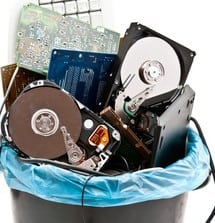Garbage In/Garbage Out – Digging Your Way Out

Since it was first coined in the world of computer science in the 1950s, the phrase “garbage in, garbage out” has been a popular metaphor for flawed, or nonsense data input that produces flawed or nonsense output, aka “garbage.”
For those of us who are old enough to remember when the term was thrown around by computer salespeople or a firm’s resident technology geek, you may also recall what data management was like before before the days of Windows or Mac OS X. Picture black screens filled with green or orange text and a flashing cursor, and typing in pages of commands, only to execute and then get no results because somewhere buried in the midst of millions of lines of code, one character was in the wrong place! This was how the hard lessons of garbage data were learned.
Garbage In
But it seems like bad data would have become a thing of the past with today’s slick operating systems and sophisticated apps and software that scrape signatures and enhance data to help us more easily keep our contact data straight. After all, we have Google and LinkedIn to help us find accurate contact information, smart phones with autocorrect and predictive text and CRM systems that automatically gather all this data and store it in a central location. Yet despite all the technology at our fingertips, the “garbage” continues to pile up.
While no one intentionally enters nonsense or flawed data into CRM systems, it happens every day. Even in a perfect world where all contact data would be accurate upon entry into your system, within a day, a week or a month, the integrity of that data deteriorates to the point where the once squeaky-clean contact record with a correct name, address, phone number and email can become “trashed.”
People change their names and, in turn, their email addresses changes. They get promoted, quit their jobs and move to different companies or places. Companies relocate, get acquired, go out of business, change domain names, addresses and phone numbers. Pretty soon, the bad data just starts piling up in your CRM – where it inevitably causes a heap of problems – becoming a literal “landfill” of garbage.
Taking the Garbage Out
So why is it important to dump your bad data? Once your data gets trashed, the benefits of the information diminish. Insights you hope to gain become muddied. Reporting based on the inaccurate data skews the information and its analysis. Flawed analysis can give you the impression things are going well when, in fact, your business may be in trouble and you just don’t know it. Or, conversely, it can appear that the company is having problems when it’s actually doing just fine. Either way, you lack a clear view of where you really stand. What’s more, bad data hinders CRM adoption, another big problem.
Regardless of the technological advances, systems and CRMs still rely heavily on people to enter correct data and maintain it so that the output is reasonable and reliable. Therein lies the real problem: people. You may have the best systems and software, but without regular and consistent maintenance of the data, they are all simply expensive investments in your marketing and business development budget that fail to deliver returns.
Your CRM system and the data it contains requires constant and ongoing maintenance. Don’t let anyone tell you otherwise. They need proper configuration, regular research and ongoing upkeep to work together effectively and produce reliable information to help you achieve your business goals.
Putting a Lid on the Garbage
By the time you recognize that you have a garbage data problem, the magnitude of it can often be daunting. But don’t give up. Like they say, admitting that you have the problem is the first step to solving it.
Additionally, here are a few simple steps you can take to stop the garbage from piling up and some procedures you can establish to prevent it from filling up your CRM again.
- Assess the Mess – Start by evaluating your data problems. A professional data quality assessment can be a great help for gauging the extent of the issues and more accurately scoping out the time and effort that will be required to scrap all the bad data.
- Strategize – Effective data quality starts with a plan. Once you have evaluated the problems with your data, you need to come up with a strategy for the best way to fix things. What is the most effective and cost-effective way to approach the project?
- Prioritize – Don’t try to boil the ocean. Instead consider starting with a small subset of key contacts. Determine which contacts are the most important to your business and which ones your users care about the most such as top clients or business development prospects. Often these are the contacts where your focus can yield the best results and ROI.
- Dedicate Resources – Once you prioritize the problems with your data, it’s essential to dedicate the resources needed to clean up the garbage and ensure good quality data going forward. When it comes to data quality, there is no substitute for trained data cleansing professionals or data stewards. These are individuals who are trained in both CRM and research skills and can not only clean but even enhance your data. Additionally, don’t forget to create a data quality styles and standards to guide both your data stewards and your users.
- Sanitize – Once you have the resources lined up, it’s time to get to work. Focus on key projects that will produce results and enhance communication. Start with duplicates and records with missing key information such as email addresses. Consider validating addresses for contacts in other countries that could expose you to liability for violations of anti-SPAM or data privacy regulations. Look for incomplete information, inconsistent formatting, irrelevant data and/or emails that have bounced during recent campaigns.
- Repeat – Remember, maintaining good data quality never ends. Research shows that, without ongoing attention, up to 30% of your data can quickly degrade each year. Good contact records inevitably become bad ones, and the garbage can start to pile up quickly again, so the focus on data quality has to be both constant and continuous to break the bad data cycle.
Still Frustrated with CRM Data Quality Issues? Reach out for help.
Since 2007, the CLIENTSFirst team has helped hundreds of organizations assess their CRM data quality, plan for success, and establish data standards, protocols and procedures. Additionally, our team of trained outsourced data quality professionals and managers can provide full-time or project-based assistance to help you with data quality tasks.
If your firm is tired of taking out the garbage data, contact us for a complimentary assessment at info@clientsfirstconsulting.com or 404-249-9914. We are happy to help.
Download a PDF of the article
– For more than 10 years, the team at CLIENTSFirst Consulting has been helping professional services firms and other organizations successfully select and implement CRM and eMarketing systems to maximize value, adoption and return on investment. If you need help with CRM Success, please contact us at 404-249-9914 or Info@ClientsFirstConsulting.com.







